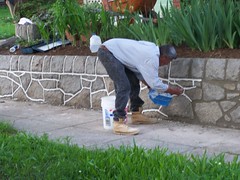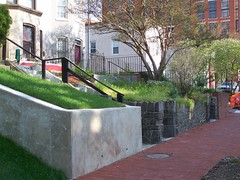Speaking of green collar jobs
Historic preservation trades are green collar jobs, but aren't conceived of such in DC's campaign to focus on workforce development in the green economy. It's not that preservation isn't considered sustainable, but the focus is on new industries. From the webpage:
The District defines Green Collar Jobs as career-track employment opportunities in emerging environmental industries, as well as conventional businesses and trades, created by a shift to more sustainable practices, materials, and performance. It includes both lower and higher skilled employment opportunities that minimize the carbon footprint of all inputs necessary and directly result in: the restoration of the environment, the generation of clean energy and improved energy efficiency, the creation of high performing buildings, and the conservation of natural resources.
- District of Columbia Green Collar Jobs Demand Analysis Final Report
If you own a historic house, or one eligible for designation, think of how hard it can be to find someone qualified and able to do quality work and (2) how much you pay them. It's not cheap even though the results are well worth it.

Application of period-appropriate beading while repairing a stone retaining wall on 3rd Street NW, Washington, DC.

Inappropriately replaced "historic" retaining wall on 2nd Street NE.
In typical historic preservation projects, 70% of the cost of the job is labor, and 30% of the cost of the job is materials. Most of the profits on the sale of materials don't stay local, either within the city or the region.

Department signs hang at a Home Depot story in Chicago, Friday, Aug. 8, 2008. The Home Depot Inc., the nation's largest home improvement retailer. (AP Photo/Charles Rex Arbogast)
On new construction jobs, 50% of the cost is labor; 50% materials. So the multiplier effect on the economy of new construction isn't as great when compared to historic preservation-based construction.
One of the things I proposed some years ago was creating a preservation training program in the high school level + community college equivalent, based on the Preservation Arts Department at the High School of the Arts in Brooklyn, and other programs. We proposed that as a possible use in the Crummell School in Ivy City, but the guy we were working with in Ivy City got wacked out, and we ended up scuttling the project. It needs to be taken up again.
You can't get more sustainable than having a house that is a couple hundred years old. (Ours is only 80 years old--this October.)

This sink is not original to the house. It's from 1951 and we bought it at Brass Knob warehouse. The first plumber we had was congenitally unable to grasp dealing with a "historic" sink and valves. We had to fire him (after spending way too much money on him, none of which we got back) and found another (through Brass Knob Warehouse) who still likes new equipment but is fully prepared to deal with "old" components and is willing to consult with experts (in the case of old Crane sinks, DEA Bathroom Machineries is the national expert) for insight and guidance on how to make it work. (The subway tiles on the wall are original. There are some tiles we need to replace because of the butchery of the first plumber.)
Labels: building a local economy, economic development, green construction, green-environment-urban, historic preservation



0 Comments:
Post a Comment
<< Home